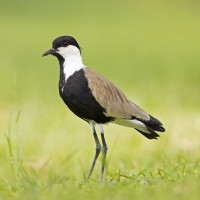Description
Faneromeni Beach is one of the popular birdingplaces on the island of Lesvos during, especially, spring migration. The area consists of a coastal area with agricultural fields, orchards and small rivers with high reedbeds. The valley is lush green and full of bushes, trees and meadows while the surrounding area is barren, rocky and dry; a perfect stop-over for migrating birds. The beach contains typical shrubs which are often used by Crested Lark as lookout posts. Rufous-tailed Scrub Robin can also be found here and forages between the shrubs and the fields adjacent to the beach. The river mouth is excellent for many bird species, like waders, herons, pipits and storks. The surrounding reedbeds are perfect for Little Bittern and Great Reed Warbler. In the river itself, many species of wader, like Little Stint, can be seen. The river mouth is also a perfect location for Citrine Wagtail.
From the beach, you'll have a perfect vantage point over sea, where many gulls and large flocks of shearwater can be seen. Flocks of 100+ Yelkouan Shearwater can be spotted from here with often a few Scopoli's Shearwater between them. Flocks of Yellow-legged Gull can be found on the beach and Audouin's Gull has often been found here too.
The fields adjacent to the beach consist of open agricultural fields with many fences, power lines and scattered trees. Directly near the beach a house is located with higher trees. Groups of Rosy Starling are often found in this area. The fields are always worth a check for migrants of all kinds, especially in the early morning. Many pipits and wagtails, like Western Yellow Wagtail and Red-throated Pipit, can be seen here. Buntings use the power lines as vantage point, like Black-headed Bunting and Corn Bunting. The bushes are often used by many species of shrike, like Lesser Grey Shrike, Woodchat Shrike and Masked Shrike. Some barbed wire next to the road, especially in the vicinity of bushes, can be full of speared beetles and other prey species of these shrikes. Above the fields, harriers, like Hen Harrier and Pallid Harrier, hunt for prey. Spur-winged Lapwing is often spotted on these fields.
Even further inland, the agricultural fields are replaced by fig and olive orchards. These orchards are used by many migrants, like flycatchers and warblers. Golden Oriole is often heard from within these orchards. Passing larger migrants, like storks and raptors can easily be seen from these areas. Large flocks of Red-footed Falcon can be present on the power lines. Lesser Kestrel hunts in and around these orchards and fields and return with prey to their nests (mainly) on the island of Megalonisi. If you're lucky, you'll find a passing Levant Sparrowhawk.
The area surrounding the river, which eventually flows into the sea on Faneromeni Beach, is good for many species of migrants and local reedbirds. The road goes through the river and is a very good spot to observe drinking birds, like flocks of Spanish Sparrow and many other songbirds. When the water is relatively low, this spot is perfect for observing other waterbirds, like waders and herons. Just north of this crossing, the landscape is pretty rocky. Here, flocks of Rock Dove can be found.
Details
Access
The area is easy accessable, especially by foot. Most of the track is tarmac and easy to walk on. The best way to walk around is to drive towards the restaurant on the beach, park your car there and walk around counter clockwise. Therefore, you'll need to cross the river mouth, so keep in mind you'll need the right equipment to cross, but most of the times the crossing is just a meter of water in width. You'll have to climb some rocks to continue your track, but this is fairly easy to do, even with telescope and camera.

